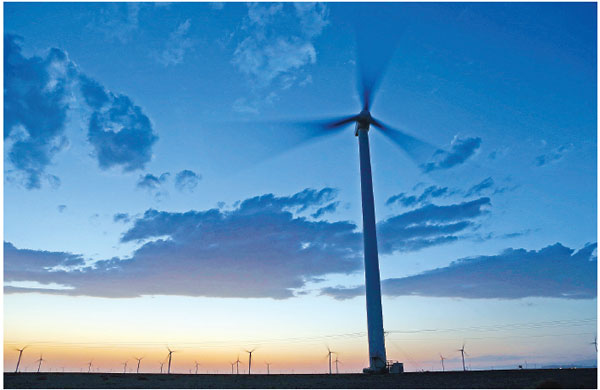China embrace of wind fuels green hopes
By KARL WILSON in Sydney | China Daily | Updated: 2021-03-16 10:03

World-beating lead in new capacity firms up renewables shift to aid climate
China's achievement in leading the world for a third consecutive year in adding offshore wind capacity-despite the pandemic-marks out the way ahead in the global fight against climate change, according to analysts.
The Global Wind Energy Council, in its latest market report, said the global offshore wind industry in 2020 had its second-best year, with over 6 gigawatts of new capacity installed.
Half of the growth came from China, which added a record 3 GW capacity. It has topped the world's new installments each year since 2018.
Feng Zhao, head of market intelligence and strategy at GWEC, said: "The continued growth of the offshore wind industry globally throughout the pandemic is a testament to the resilience of this booming industry."
Although China was hit by the COVID-19 crisis, the impact on the offshore wind sector was minimal, with the country resuming "business as usual" as early as March 2020.
China's record-breaking growth is expected to continue in 2021, driven by an offshore wind installation rush to meet China's feed-in-tariff deadline by the end of this year, Zhao said.
The report, dated Feb 25, said China has surpassed Germany in terms of cumulative installations, becoming the second-largest offshore wind generator globally after the UK.
"China had a construction backlog of more than 10 GW going into 2020 and Chinese developers are racing to reach maximum commissioning by the end of the year to claim full feed-in-tariffs," said Alexander Flotre, Rystad Energy's project manager for Offshore Wind.
"This means 2021 is going to see major capacity additions, particularly since some projects initially scheduled for commissioning in 2020 ended up slipping into 2021."
China is forecast to see high activity levels continue between 2021 and 2024, before slowing down in 2025.
According to the GWEC data, steady growth in Europe accounted for most of the remaining new capacity last year, led by the Netherlands with nearly 1.5 GW of new offshore wind installations in 2020. It was the second-largest market for new capacity that year after China.
While Europe remains the largest offshore wind market globally, the Asia Pacific will play an increasingly important role driving industry growth as major economies such as Japan and South Korea have recently established ambitious offshore wind targets, Zhao said in a statement.
From almost no offshore wind farms in 2015, Asia's operational capacity has grown to more than 6 GW today, according to Rystad Energy, an independent global energy consultancy.
The US can also become an increasingly important market for offshore wind, as the new administration has made it clear it is working to accelerate growth in this crucial industry.
Offshore expansion
Rystad expects the global installed offshore wind capacity to increase by 11.8 GW in 2021, with China continuing to lead the new capacity additions, contributing 63 percent of the expected growth.
With China planning to phase out feed-in-tariffs by the end of this year, many developers are rushing to complete projects, Rystad said.
Robert Liew, principal analyst at energy and resources consultancy Wood Mackenzie, said floating offshore wind platforms "could be the net frontier in wind power development" in Asia.
He said a significant market for floating offshore technology is now starting to emerge in Asia as a number of demonstration projects are being planned.
"Maintaining power supply will be a key challenge for Asia as legacy thermal plants reach the end of their project life and the opportunity for new-build coal and nuclear are severely limited," Liew said.
Liew said East Asian markets in South Korea and Japan plus China's Taiwan face projected thermal and nuclear capacity retirements totaling 89 GW over the next 10 years.
"Floating offshore wind is starting to gain more attention, but the high cost remains a major barrier to the widespread adoption of this technology," he said.
























